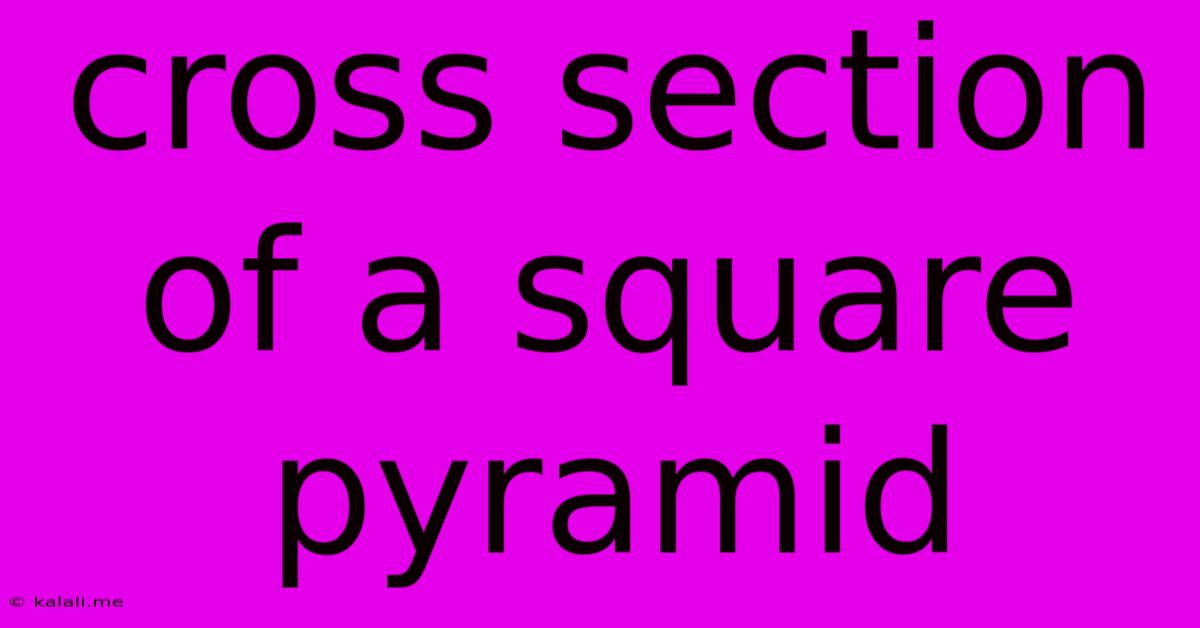Cross Section Of A Square Pyramid
Kalali
May 10, 2025 · 3 min read

Table of Contents
Understanding the Cross Section of a Square Pyramid
A square pyramid, a three-dimensional shape with a square base and four triangular faces meeting at a single apex, presents interesting geometrical properties when dissected. This article explores the various cross sections possible when slicing through a square pyramid, focusing on the shapes and conditions that create them. Understanding these cross-sections is crucial in various fields like architecture, engineering, and geometry education.
What is a Cross Section?
A cross section is the two-dimensional shape revealed when a three-dimensional object is cut through by a plane. The shape of the cross section depends on the orientation of the cutting plane relative to the object's geometry. In the case of a square pyramid, different cutting planes yield different cross-sectional shapes.
Possible Cross Sections of a Square Pyramid
The cross section of a square pyramid can take on several forms, depending on how the cutting plane intersects the pyramid:
-
Square: A plane parallel to the base of the square pyramid will produce a square cross section. This square will be smaller than the base, its size depending on the distance from the plane to the pyramid's apex. Imagine slicing a perfectly level cut through the middle - you'd get a smaller, similar square.
-
Rectangle: A plane that intersects all four triangular faces, but not parallel to the base, will reveal a rectangular cross section. The rectangle's dimensions will vary depending on the angle of the plane. The closer the plane is to being parallel to the base, the more square-like the rectangle becomes.
-
Trapezoid (Trapezium): A plane that intersects the base and two adjacent triangular faces at angles other than parallel to the base will result in a trapezoid. This is probably the most commonly encountered cross-section, showcasing the transition between a square and a triangle. The size and shape of the trapezoid depend on the angle and position of the cutting plane.
-
Triangle: A plane that intersects the pyramid's apex and two opposite edges of the base will create a triangular cross section. This cross section is an isosceles triangle, its properties derived from the pyramid's symmetrical nature. The size of this triangle will vary based on the precise orientation of the plane.
-
Other Irregular Shapes: While less common or easily defined, a plane slicing the pyramid at more complex angles could theoretically produce irregular polygonal cross sections. These would be harder to precisely predict without advanced geometrical calculations.
Understanding the Relationship Between Plane and Shape
The key to understanding the cross sections lies in visualizing how the cutting plane interacts with the different faces and edges of the square pyramid. The orientation of the plane is the critical factor determining the shape and size of the resulting cross section. Think of it as ‘slicing’ the pyramid—the angle of your knife dictates the shape of the slice.
Applications and Further Exploration
The analysis of cross sections is crucial in various engineering and design applications. Architects use this knowledge to understand the structural integrity of pyramidal designs. Civil engineers can use it to plan cuts and excavations for projects involving pyramidal structures. Furthermore, exploring different cross-sectional planes provides valuable insights into spatial reasoning and three-dimensional geometry.
By understanding the various cross sections of a square pyramid, we gain a deeper understanding of the three-dimensional shape and its properties. This knowledge is invaluable for solving geometry problems and applying geometrical concepts to real-world scenarios.
Latest Posts
Latest Posts
-
Jaguar Adaptations In The Tropical Rainforest
May 10, 2025
-
How To Find Average Velocity From Velocity Time Graph
May 10, 2025
-
What Is Non Living Things In The Ecosystem
May 10, 2025
-
How Many Fl Oz In 6 Cups
May 10, 2025
-
What Is 1 Percent Of 5000
May 10, 2025
Related Post
Thank you for visiting our website which covers about Cross Section Of A Square Pyramid . We hope the information provided has been useful to you. Feel free to contact us if you have any questions or need further assistance. See you next time and don't miss to bookmark.